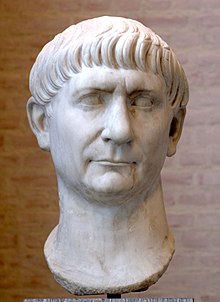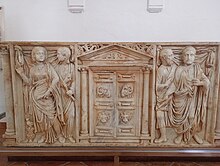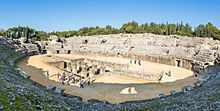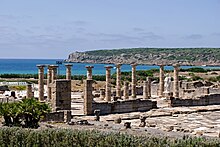Hispania Baetica
| Provincia Hispania Baetica | |||||||||
|---|---|---|---|---|---|---|---|---|---|
| Province of the Roman Empire | |||||||||
| 14 BC–5th century | |||||||||
 The Roman province of Hispania Baetica, c. 125 AD | |||||||||
| Capital | Corduba | ||||||||
| Historical era | Antiquity | ||||||||
• Established | 14 BC | ||||||||
• Visigothic conquest | 5th century | ||||||||
| |||||||||





Hispania Baetica, often abbreviated Baetica, was one of three Roman provinces created in Hispania (the Iberian Peninsula) on 27 BC. Baetica was bordered to the west by Lusitania, and to the northeast by Tarraconensis. Baetica remained one of the basic divisions of Hispania under the Visigoths. Its territory approximately corresponds to modern Andalusia.
Name
In
History

Before

Some of the Iberian cities retained their pre-Indo-European names in Baetica throughout the Roman era. Granada was called Eliberri, Illiberis and Illiber by the Romans; in Basque, "iri-berri" or "ili-berri", still signifies "new town".[citation needed]


The south of the Iberian peninsula was agriculturally rich, providing for export of
In the reorganization of the Empire in 14 BC, Baetica was made a senatorial province, which means it was governed by a



Baetica was divided into four


Baetica was rich and strongly Romanized, attracting colonists and merchants from Italy. Since the 1st century BC it produced outstanding figures like the aforementioned Columella, the rethorician
Baetica also gave Rome two emperors. Trajan, the first emperor since Claudius to be of provincial birth, though of Italic stock, was born in Itálica (Baetica), a colony established in 206 BC by Scipio Africanus for Roman veterans of the Second Punic War.[1] Trajan's kinsman and successor Hadrian also came from Itálica. Marcus Aurelius, though born in Rome, had ancestors born in the town of Ucubi (modern day Espejo), a Roman colony not far from Córdoba.
Baetica enjoyed Pax Romana for most of imperial history, though it faced a permanent threat stemming from Africa from the 2nd century AD. On 171 groups of mauri (natives of Mauretania Tingitana, roughly modern day Morocco) crossed the Strait of Gibraltar and looted rural towns for months until they were expelled. A century later, in 296-297, Emperor Maximian built a massive palace nearby Córdoba from where to command the campaign against piracy in the Strait and Berber incursions in Mauritania.
Baetica was Roman until the brief invasion of the
Proconsuls

The Province was governed by a proconsul who had formerly been a praetor.
| Proconsuls | Term Start | Term End |
|---|---|---|
| Gaius Vibius Serenus[2] | 20 AD | 22 AD |
| Gaius Caetronius Miccio | c. 37 AD | c. 38 AD |
| Umbonĭus Silĭo[3] | 43 AD | 44 AD |
| Marcus Ulpius Traianus[4] | ? | Before 67 AD |
| Lucius Lucullus[5] | 70s AD | 70s AD |
| [? Marcus] Sempronius Fuscus[6] | 78 AD | 79 AD |
| Gaius Cornelius Gallicanus | 79 AD | 80 AD |
| Lucius Antistius Rusticus | 83 AD | 84 AD |
| Baebius Massa | 91 AD | 92 AD |
| Galeo Tettienus Severus Marcus Eppuleius Proculus Tiberius Caepio Hispo | 95 AD | 96 AD |
| ? Gallus | 96 AD | 97 AD |
| Gaius Caecilius Classicus | 97 AD | 98 AD |
| Quintus Baebius Macer | 100 AD | 101 AD |
| Instanius Rufus | 101 AD | 102 AD |
| ? Lustricius Bruttianus | Before 107 AD | Before 107 AD |
| [? Titus] Calestrius Tiro | 107 AD | 108 AD |
| Egnatius Taurinus | between 138 AD and 143 AD | between 138 AD and 143 AD |
| ? Gaius Julius Proculus | 122 AD | 123 AD |
| Publius Tullius Varro | 123 AD | 124 AD |
| Lucius Flavius Arrianus | before 129 AD | before 129 AD |
| Gaius Javolenus Calvinus[7] | between 138 AD and 143 AD | between 138 AD and 143 AD |
| Aelius Marcianus | between 138 AD and 161 AD | between 138 AD and 161 AD |
| Publius Statius Paullus Postumus Junior | middle of the 2nd century | middle of the 2nd century |
| Publius Cornelius Anullinus | 170 AD | 171 AD |
| Gaius Aufidius Victorinus | 171 AD | 171 AD |
| Gaius Memmius Fidus Julius Albius[8] | 183 AD | 183 AD |
| Caecilius Aemilianus[8] | 215 AD | 215 AD |
| Aulus Caecina Tacitus[9] | first half 3rd century | first half 3rd century |
| L. Sempronius O[...] Celsus [Servi]lius Fabianus[10] | first half 3rd century | first half 3rd century |
| Quintus Pomponius Munat[ianus?] Clodianus[11] | first half 3rd century | first half 3rd century |
See also
- Pre-Roman peoples of the Iberian Peninsula
- Romanization of Hispania
- Spania
References
Citations
- ^ Arnold Blumberg, "Great Leaders, Great Tyrants? Contemporary Views of World Rulers who Made History", 1995, Greenwood Publishing Group, p.315
- Annalesiv.13
- Dio Cassius, 60.21.5
- ^ Paul Leunissen, "Direct Promotions from Proconsul to Consul under the Principate", Zeitschrift für Papyrologie und Epigraphik, 89 (1991), p. 236
- Naturalis Historia9.48
- ^ Unless otherwise noted, governors from 78/79 to 136/137 are taken from Werner Eck, "Jahres- und Provinzialfasten der senatorischen Statthalter von 69/70 bis 138/139", Chiron, 12 (1982), pp. 281–362; 13 (1983), pp. 147–237.
- ^ Unless otherwise noted, the governors from 138 through 180 are taken from Géza Alföldy, Konsulat und Senatorenstand unter der Antoninen (Bonn: Rudolf Habelt Verlag, 1977), pp. 262f
- ^ a b Paul M. M. Leunissen, Konsuln und Konsulare in der Zeit von Commodus bis Severus Alexander (1989) p. 297
- ^ Leunissen, "Direct promotions", p. 249
- ^ CIL VI, 15113
- ^ Leunissen, "Direct promotions", pp. 249f
Bibliography
- Carmen Castillo García, Prosopographia Baetica (Collective biographies of Baetica), 1968[1]
- Carmen Castillo García, Städte und Personen der Baetica (Settlements in Baetica), 1975[2]
- A.T. Fear, Rome and Baetica: Urbanization in Southern Spain, C. 50 BC – AD 150 in the series "Oxford Classical Monographs".
- Evan Haley, Baetica Felix: People and Prosperity in Southern Spain from Caesar to Septimius Severus, (excerpt from the Introduction).
- El Housin Helal Ouriachen, 2009, La ciudad bética durante la Antigüedad Tardía. Persistencias y mutaciones locales en relación con la realidad urbana del Mediterraneo y del Atlántico, Tesis doctoral, Universidad de Granada, Granada.
External links
- "Baetica, the great olive oil producer"
- Detailed map of the Pre-Roman Peoples of Iberia (around 200 BC)
37°30′00″N 6°00′00″W / 37.5000°N 6.0000°W
- ^ García, Carmen Castillo (1968). Prosopographia Baetica (in Spanish). Universidad de Navarra.
- ^ Castillo, Carmen (1975). Städte und Personen der Baetica (in German). de Gruyter.

